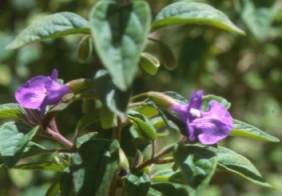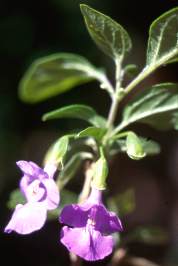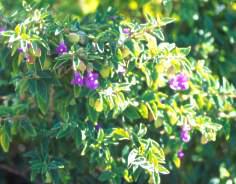Tinnea barbata
Tinnea barbata Vollesen
Family: Lamiaceae
Common names: bush violet, blue tinnea
Introduction
This superb little shrub is related to salvias. The delicate deep purple-blue flowers dangling from erect branches like little ornaments are this shrub's best feature.

Description
Description
This multi-stemmed, woody, perennial shrub can reach a height of 3 m, but usually only achieves half that height. The leaves are hairy and gland-dotted, dull to dark green and paler underneath. The bushviolet has a long flowering period through summer with showy, deep blue or pale to dark mauve flowers centred with bright yellow stamens.The base of the flower is enclosed by a green, bulbous calyx. While not quite free-flowering, the flowers are scattered attractively over the shrub as they are borne at the ends of the many branches. The calyx enlarges and inflates to enclose the winged fruit which is a bladder-like nutlet, green with a purplish tinge. T. barbata is relatively slow growing and can be regarded as rare because of its extremely restricted distribution.

Conservation Status
Status
Tinnea barbata is not threatened.
Distribution and habitat
Distribution description
Tinnea barbata appears to be restricted to the mountain massif between Barberton and Pigs Peak and must be quite rare because neither Galpin nor Thorncroft, both eagle-eyed collectors, found it. In addition, it grows as an understorey shrub or small tree at forest margins or along wooded stream banks and so may be easily overlooked. As it naturally occurs at altitudes of 1 200 - 1 400 m above sea level, it is most likely frost tolerant. This is a summer rainfall region and the plant requires water during the hot summer months.

Derivation of name and historical aspects
History
This interesting plant was first collected by a forestry officer from the Barberton Mountains in 1956. Unfortunately, the identity of the collector is uncertain. The only other known collections have been made by Prof. R.H. Compton from the Piggs Peak area and Dr D. Edwards who collected it from the Ida Doyer Nature Reserve in 1968. This is its type locality.
The genus Tinnea was named after the Tinne family from Holland who were patrons of botany in the 1800s in order to commemorate a scientific expedition on the Nile in 1861 during which Henrietta Tinne and her two daughters collected seed of T.aethiopica. The epithet barbata means bearded and probably referrs to the beard-like appearance of the winged nutlet fruit.
Tinnea belongs to the family Lamiaceae (Labiatae) and is a genus of 19 species restricted to Africa. Three species occur in Mpumalanga, two of which are woody shrubs taller than 1.5 m. Of the species recorded in South Africa, T. barbata is the only one with violet-coloured flowers. The others have brown flowers.
Growing Tinnea barbata
Grow
It is an excellent garden subject if planted in a warm, sunny or even semi-shaded position in rich, well-drained, composted soil. It is also a lovely plant in a small or medium container for patios or verandas in good light conditions. The plant responds well to pruning for shape in late winter. It propagates easily from seed, but is best not kept too wet. Regular feeding with both general fertilizer and those containing trace elements will keep the foliage healthy and green. At Kirstenbosch it is grown from seed, but it may be possible to propagate it from semi-hardwood cuttings.
References
- CODD, L.E. 1979. Tinnea barbata. The Flowering Plants of Africa 46: t. 1813. Botanical Research Institute, Pretoria.
- KRUGER, P.R. 1978. Tinnea barbata Veld & Flora 63:112-113.
- POOLEY, E. 1998. A field guide to wild flowers of Kwazulu-Natal and the eastern Region. Natal Flora Publications Trust, Durban.
- POWRIE, F. 1998. Grow South African plants. National Botanical Institute, Cape Town.
- SCHMIDT, E. 2002. Trees and shrubs of Mpumalanga and the Kruger National Park. Jacaranda Publishers, Johannesburg.
Credits
Cherise Viljoen
Kirstenbosch National Botanical Garden
May 2003
Plant Attributes:
Plant Type: Shrub
SA Distribution: KwaZulu-Natal, Mpumalanga
Soil type: Clay, Loam
Flowering season: Early Summer, Late Summer, Autumn
PH: Neutral
Flower colour: Blue, Purple
Aspect: Full Sun, Shade, Morning Sun (Semi Shade), Afternoon Sun (Semi Shade)
Gardening skill: Average
Special Features:
Horticultural zones











Rate this article
Article well written and informative
Rate this plant
Is this an interesting plant?
Login to add your Comment
Back to topNot registered yet? Click here to register.